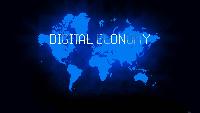
Digital economy or the internet economy is increasingly influencing our social and economy activities and even the way we live. The internet and its accessory activities including Information and Communication Technologies have given birth to new products, services, jobs, enterprises and even markets. World’s largest firms – Google’s Alphabet, Facebook and Amazon are from the digital world.
Besides the internet and the internet of things, several new inventions are about to alter the way we live and economically engage. Artificial intelligence, machine to machine communication, sensor technology, robotics, big data, cloud computing, 3 D printing etc., indicate that the role of digital technologies in economic activities are going to rise. In this context, there is increasing attempts to identify the size and importance of the digital economy in terms of its output, job creation, enterprise creation etc.
What is Digital Economy?
According to the OCED, “Digital economy is an umbrella term used to describe markets that focus on digital technologies.” It refers to the full range of our economic, social and cultural activities supported by the Internet and related information and communications technologies. “These typically involve the trade of information goods or services through electronic commerce. It operates on a layered basis, with separate segments for data transportation and applications” (OECD 2012).
The term ‘Digital Economy’ was coined in Don Tapscott’s in his best-seller ‘The Digital Economy: Promise and Peril in the Age of Networked Intelligence’ (1995). Academicians and institutions are fine tuning the concept as well as boundaries of digital economy since then. A widely-accepted understanding about digital economy is its activities on and around the digital world.
Thomas Mesenbourg (2001) has provided three main components for Digital Economy.
- e-business infrastructure (hardware, software, telecoms, networks, human capital, etc.),
- e-business (how business is conducted, any process that an organization conducts over computer-mediated networks),
- e-commerce (transfer of goods, for example when a book is sold online).
Digital economic activity results from billions of online connections among people, businesses, devices, data, and processes. The backbone of the digital economy is thus hyper-connectivity which creates interconnectedness of people, organisations, and machines that based on the Internet, mobile technology and the Internet of Things. The internet of things, which is known as the infrastructure of the information society connects physical devices, smart devices, buildings, and other items embedded with electronics, software, sensors etc. to engage in the exchange of data.
As social media, virtual reality and cloud services are expanding, the boundary between the traditional economy and digital economy is getting difficult to be identified. The OECD has included both ICT goods and services under digital economy. This means that software services are also part of the digital economy. India is the second largest (after Ireland) exporter of ICT services (mostly software) according to the UNCTAD. In the case of ICT goods export, China is the unquestionable global leader with 32% share.
*********









